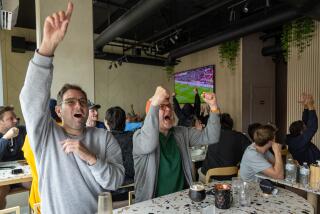Going Through the Roof
SANTA CLARITA â In the shadow of a bowling alley across the street from a family entertainment center deep inside arid Santa Clarita, a new American soccer game has taken root. Indoors.
âWell, itâs not really indoors,â said Patrick Geoffroy, 40, an aircraft mechanic and soccer buff from Valencia. âItâs played inside an enclosure, but itâs open-air, arena-style soccer. . . . Itâs a lot faster than outdoor soccer.â
Call it indoor or arena-style soccer--it makes no difference to Scott Schauer, a former produce and meat marketeer who opened the Santa Clarita Soccer Center in January. He just asks that you bring out the family and give it a chance.
In less than a year, Schauerâs recreational soccer center is drawing an estimated 2,500 players of all ages each week who enjoy the fast-paced, high-scoring game, and Schauer plans to open five more open-air soccer arenas within the next year in Palmdale, Arcadia, Ventura, Camarillo and Las Vegas.
Whatâs the attraction? The arena, though modest in scope--itâs the same size and shape as a professional ice hockey rink--has a festival-like atmosphere, with vendors, bleachers and lights for night play. A digital scoreboard ticks down time, tracks penalty minutes (in arena soccer, penalties are similar to penalties in hockey, where players who commit fouls must leave the game for periods of time, giving opponents an advantage) and records each score.
The pace is frenzied because the field is enclosed by low rounded walls and plexiglass to keep the ball in almost constant play. The smallish size of the field, the short duration of games and the small team size (six players per team compete on the field at a time) ensure that everybody--even goalkeepers and defenders--gets lots of touches on the ball and chances to score. A typical 45-minute arena soccer game averages 12 goals, whereas a typical 90-minute outdoor game score might average three goals.
The exciting style and atmosphere of the game is drawing a burgeoning crowd of soccer-hungry suburbanites, says Ron Weinstein, chairman of the Continental Indoor Soccer League, the top professional soccer league in the United States.
Thanks in part to the modest success of the CISLâs San Diego Sockers and Anaheim Splash, two professional indoor soccer teams that draw average crowds of about 7,000, recreational arena soccer is already popular in San Diego and Orange counties.
Indoor or arena soccerâs roots actually go back to the creation of the Major Indoor Soccer League in 1978. But the league competed for arena space with both hockey and basketball teams, and folded about 10 years later.
The CISL incorporated in 1990, playing in the summer when there is less demand for arenas. In Los Angeles, though, few recreational facilities have been built, perhaps because of the lack of a professional indoor soccer franchise. If the Encino-based CISL has its way, that would change soon, Weinstein said, noting that recent talk about building a new 9,000-seat hockey rink in the Valley has stirred interest among league officials in launching a new Los Angeles indoor soccer team.
âThis market, the San Fernando Valley, Thousand Oaks, Burbank area and beyond, has been long overdue for an indoor soccer center,â Weinstein said. âThese areas are hotbeds for family and youth soccer . . . and the strength and the backbone of indoor soccer are middle- and upper-income families.â
In addition to men such as Geoffroy--who grew up in Trinidad where soccer is a national pastime--those drawn to Schauerâs soccer center include a 62-year-old granddad who plays goalie, a mother who became interested after watching her sons play there, a former UCLA star who now runs an elite youth soccer camp in Pasadena, and a Guatemalan churros vendor who shuts down his cart for an hour once a week to get into the game.
âI scored nine goals last season,â said the churros vendor, 52-year-old Mario Lemus of Canyon Country. âSoccer is just getting started here in the U.S. And this place, itâs good. Friday nights, they even got teams for couples. Husband and wife.â
There are also teams brimming with intense collegiate-level players. The menâs premier league boasts teams from Cal State Northridge as well as Mission College. Players are looking to hone their skills on the fast and unforgiving artificial surface. And there are ex-patriots from all continents, most of whom grew up with soccer.
From his small, air-conditioned offices next to the roofless rink, Schauer can listen to the sound of his business booming off the walls as he recites his credo of inclusion, fairness and punctuality.
âThe difference is, Iâm not running this place as a soccer guy,â said Schauer, 38, who grew up playing football in the Valley. âIâm running it as a businessman. . . . I have a love for the game, but I also knew there was a need for this in Santa Clarita.
âItâs good clean family fun and thatâs what weâre shooting for.â
Seven days a week, at regular 50-minute intervals, from the minute he opens each day until the city forces him to shut down each night, soccer balls smack loudly off the rounded walls and plexiglass windows that encircle the turf.
On Saturdays, the first wave of players arrives at 8 a.m., paying $7 each to compete in hourlong refereed pickup games. (The fee for league play is $50 for adults, $40 for youths.)
From then on, itâs nonstop soccer until midnight, when the center closes. On weekdays, games start at 3:30 p.m. and run until 11 p.m. âGames last 45 minutes and a new game starts every 50 minutes,â Schauer said.
The strict schedule, combined with strict rules (foul language merits immediate ejection from the game, hitting or fighting produces permanent exile) is part of the centerâs successful formula. The center opened with 80 teams, but as word spread about the new game in town, more teams signed up. Now there are 140.
On Monday nights, Larry Garcy, 62, drives about 60 miles from his job as an electronics salesman in Newbury Park to play goalie for his menâs over-40 team.
His teammates are a mixed bag--players with Hungarian, Chilean and Italian heritage. Garcy grew up in a small Polish immigrant enclave in Pennsylvania where people played soccer outside regularly. After moving to California, Garcy played on a menâs outdoor team in Simi Valley, but didnât venture into the realm of arena soccer until a few months ago, when a friend told him his team needed a goalie.
âI play primarily for exercise,â Garcy said. âIâm not a jogger or a bike rider and I donât have any artificial [exercise] machines. When I found out about this indoor soccer, I decided Iâd get out there and rumble around.â
Players also say they appreciate the rigid scheduling and rules.
âTheyâre right on track with the games,â said Geoffroy, who also helps coach a womenâs team. âThe cursing is held to a minimum, which is real good, and they carry it out in a stringent way. It tends to keep the bad guys out, and people can bring little kids, moms and dads.â
Baby boomer parents who grew up playing baseball, basketball and football are just beginning to get the soccer bug, and Schauerâs indoor facility, with its wide variety of leagues and welcoming atmosphere, is just the ticket.
âI wasnât sure about it, but weâre so into soccer, and we watch the kids play here and they love it so much, I decided to do it too,â said Jackie Holcomb, 41, whose husband also plays at the center. âThis is the first competitive sport Iâve participated in since before I had my kids.â
But itâs not a game for the meek or weak of spirit, Holcomb said.
âA week ago, one of our players sprained an ankle, and in the same game, another gal on the other team broke her foot. I did a nosedive once and took a layer of skin off my face.â
Schauer says he tries to listen to his paying, playing clients and address their needs. To combat the sometimes oppressive desert heat, he installed water misters around the arenaâs perimeter. And because coed games sometimes turned into one-man shows, with dominant male players hogging the ball and never passing, the rules were changed: Goals scored by women are worth two points to a manâs one point goal. And to prevent lopsided games, teams down by four goals can add an extra player on the field to even things up.
Said Schauer: âWeâre doing everything we can to keep this place strictly geared for fun.â








